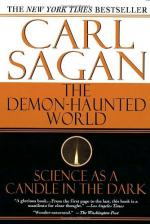|
This section contains 412 words (approx. 2 pages at 400 words per page) |

|
Chapter 23 Summary and Analysis
As a challenge to the American stereotype of the scientist as a nerd with pocket protector, glasses and no social skills, Sagan offers the story of the Scottish physicist James Clerk Maxwell. He is credited with working out the physics that made radio and television possible. In 1833, at the age of two, Maxwell discovered he could focus the image of the sun from a tin plate on surrounding furniture, and demanded an explanation of the adults in his household. In 1872, during his inaugural address as professor of experimental physics at Cambridge University, Maxwell referred to an already-existing stereotype of the scientist as some sort of misanthrope more interested in formulas and people.
Maxwell, a handsome and gregarious youth, demonstrated that a huge number of molecules in collision with each other behave according to exact statistical laws. He stated that the rings...
(read more from the Chapter 23 Summary)
|
This section contains 412 words (approx. 2 pages at 400 words per page) |

|




